Abstract
We examined the effects of physiologic infusions of arginine vasopressin (AVP) on cardiovascular hemodynamics and on reflex responses initiated by decreasing cardiopulmonary baroreceptor stimulation (with lower body negative pressure) in 10 healthy, captopril-pretreated young men (19-27 yr). Their responses were compared with those of four volunteers given isosmotic infusion. Heart rate, stroke volume, blood pressure, and forearm blood flow were measured by electrocardiography, impedance cardiography, radial artery cannulation, and strain gauge plethysmography. Two 55-min infusions of AVP at rates of 0.15 and 0.40 ng/kg per min increased average plasma concentrations from control levels of 5 pg/ml to 18 and 36 pg/ml, respectively. These infusions resulted in progressive reductions of heart rate and cardiac output and increases of forearm and total peripheral resistance. Blood pressure increases were significant only during the larger AVP infusion rate. Lower body negative pressure provoked reflex increases of total peripheral resistance. These increases were enhanced 60% during AVP infusion compared with increases during control (pre-AVP). Baseline measurements and reflex responses were unchanged by isosmotic infusions. These results demonstrate that AVP has profound effects on cardiovascular function and augments cardiopulmonary baroreflex-mediated increases of peripheral resistance in man.
Full text
PDF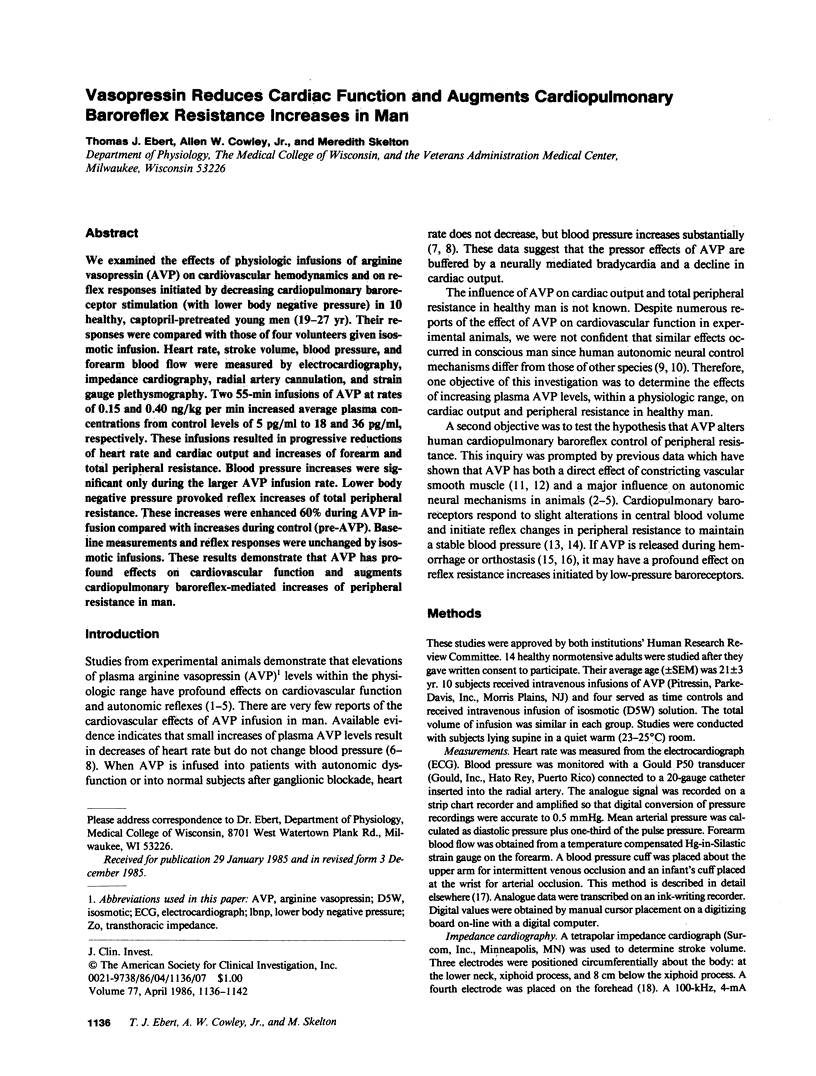
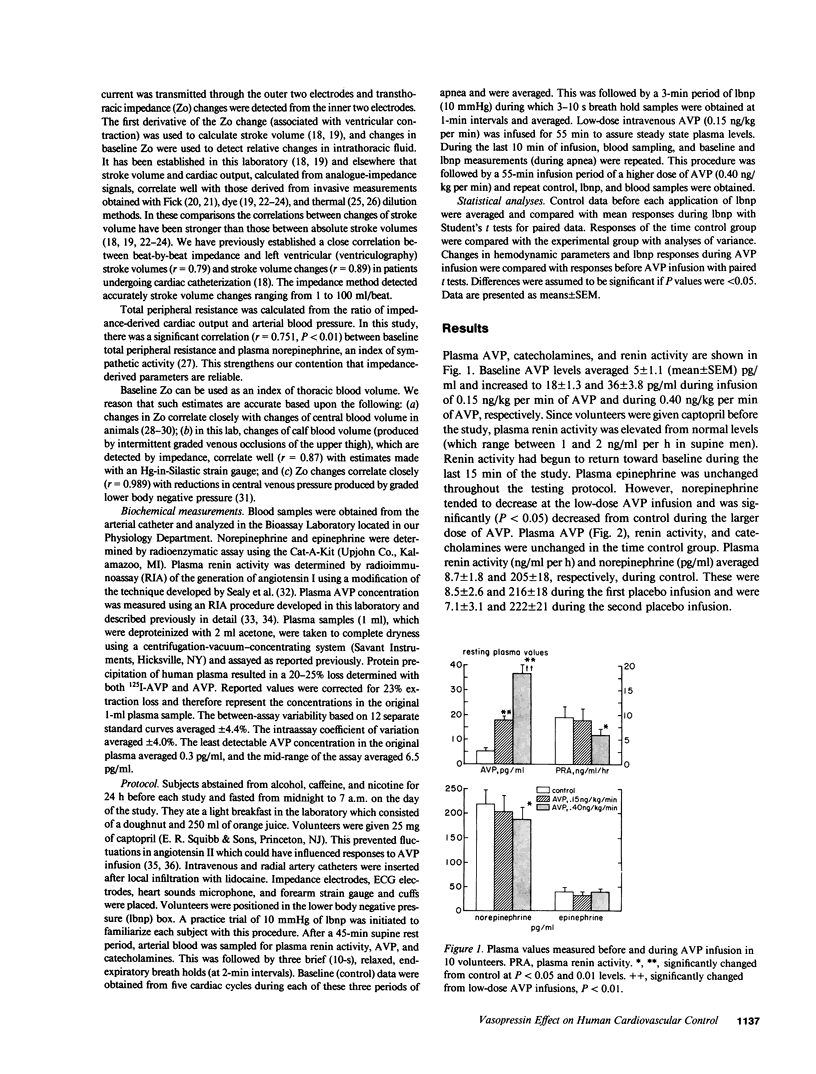
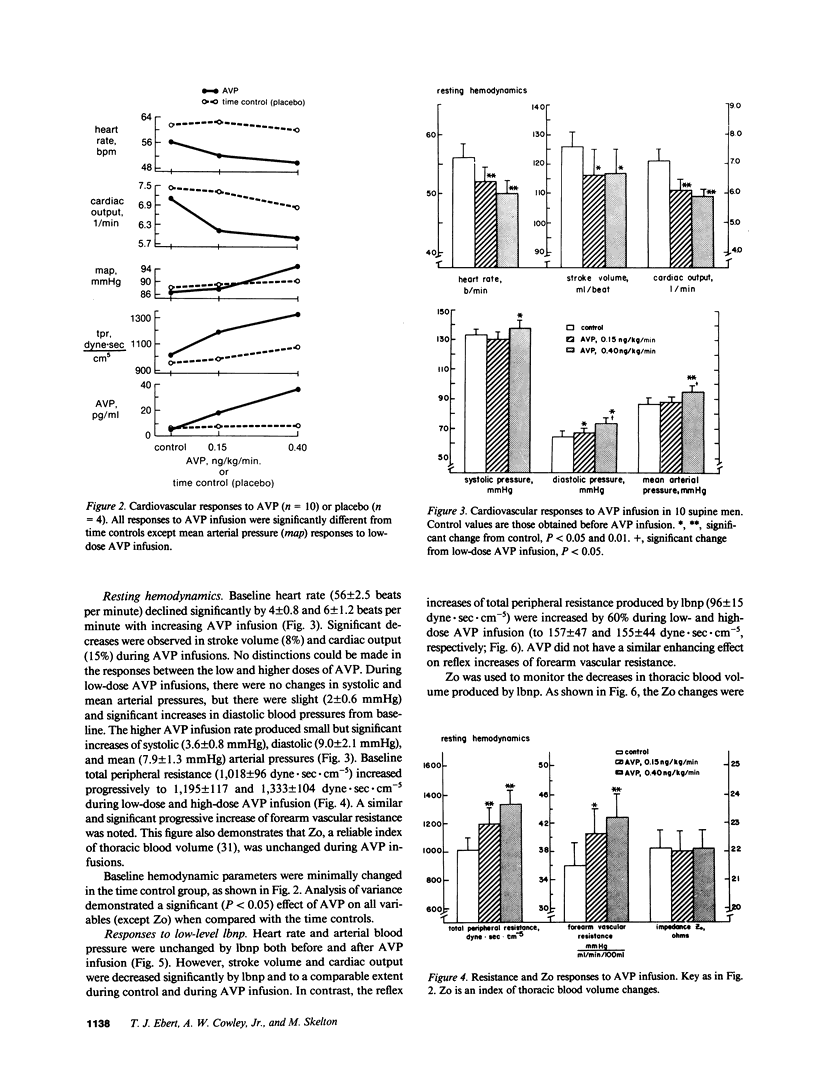
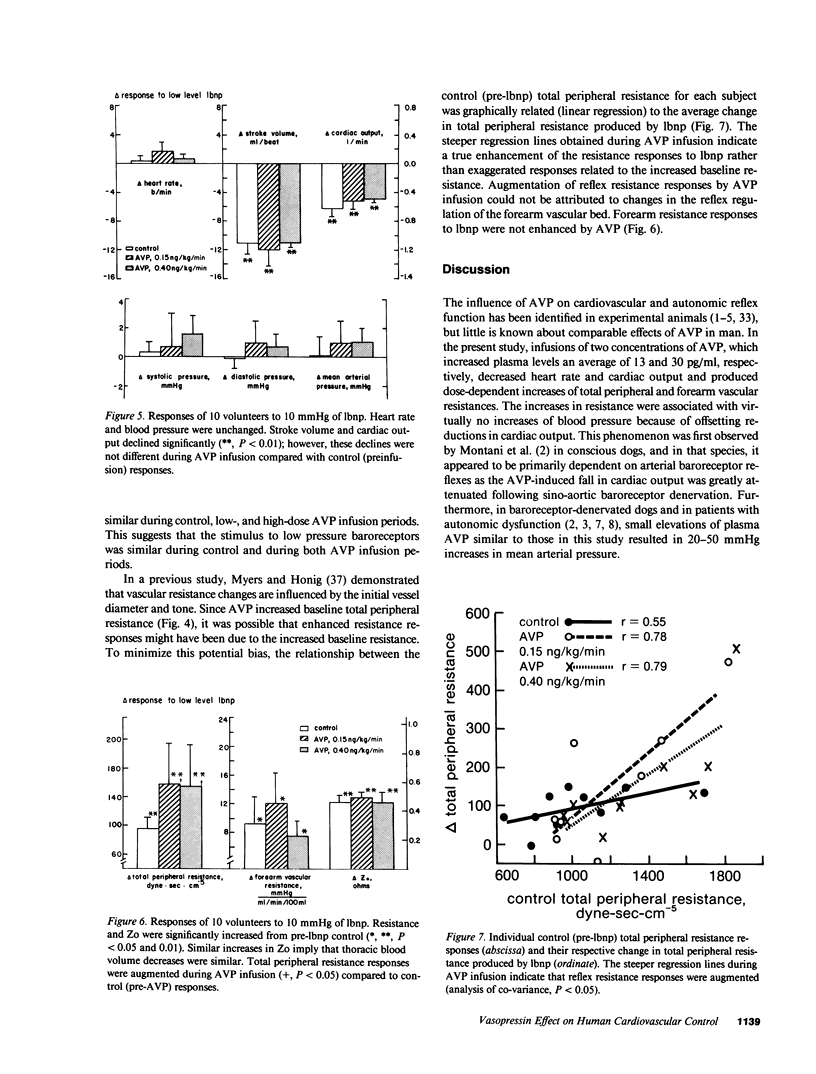
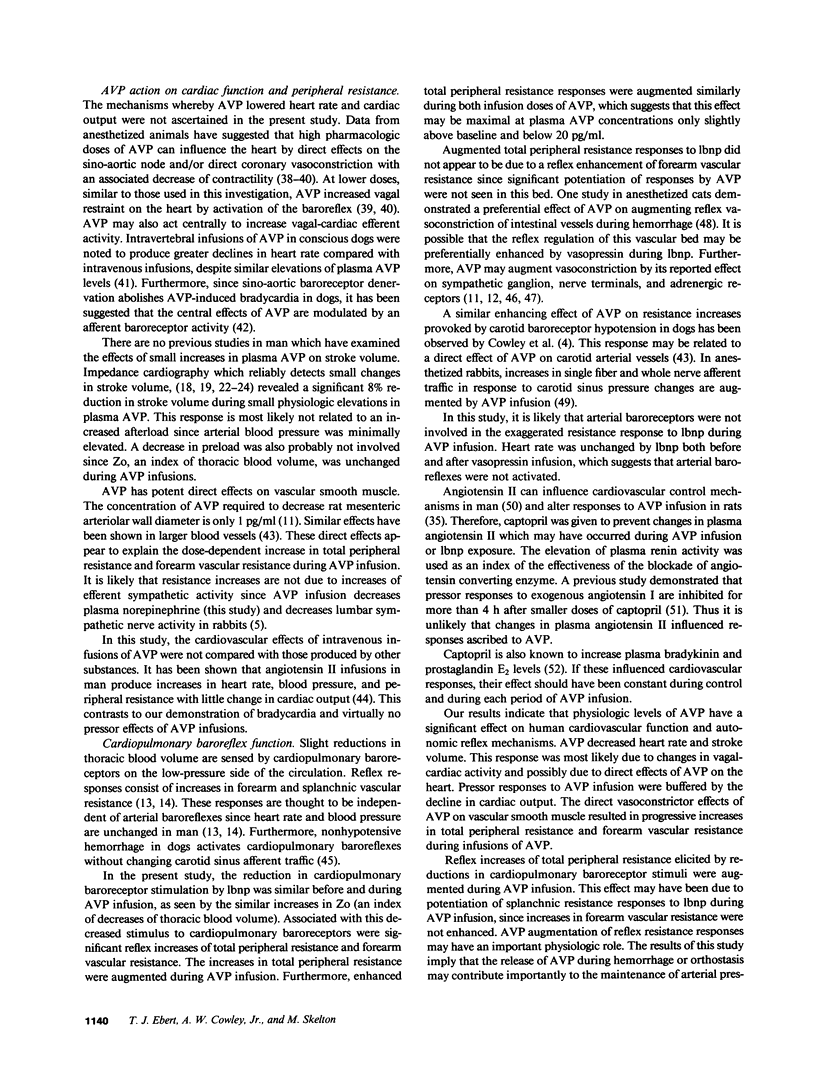
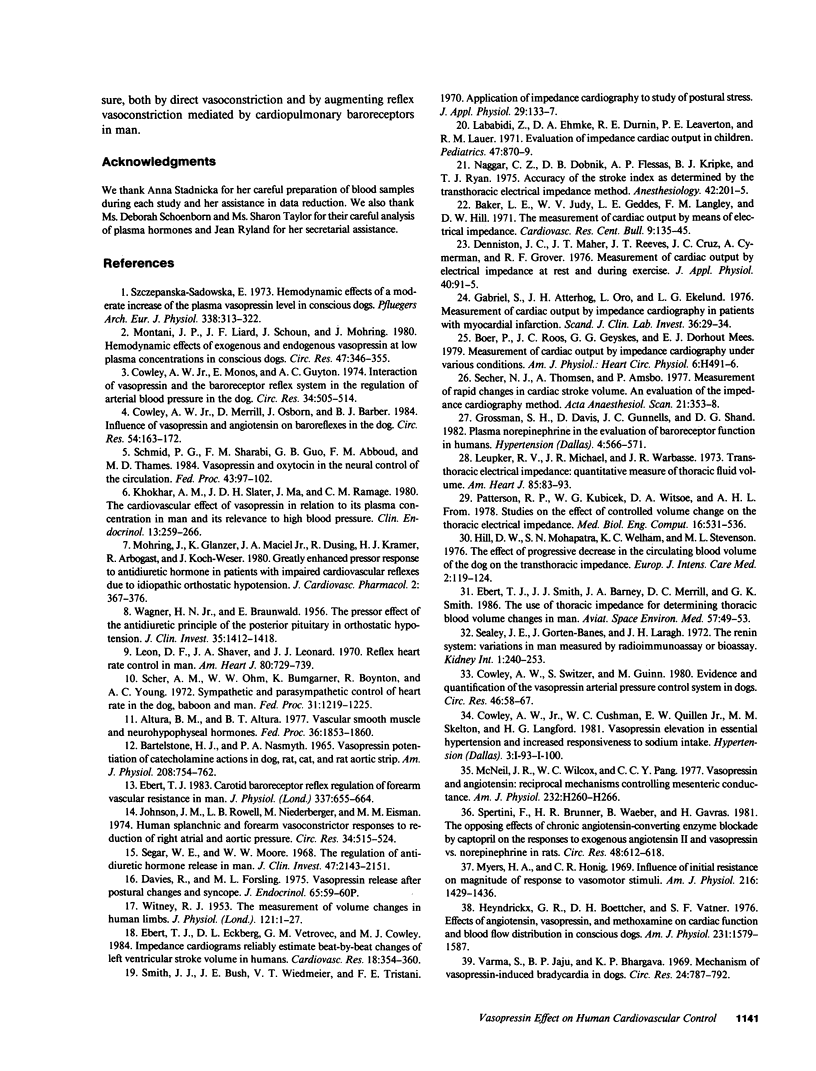
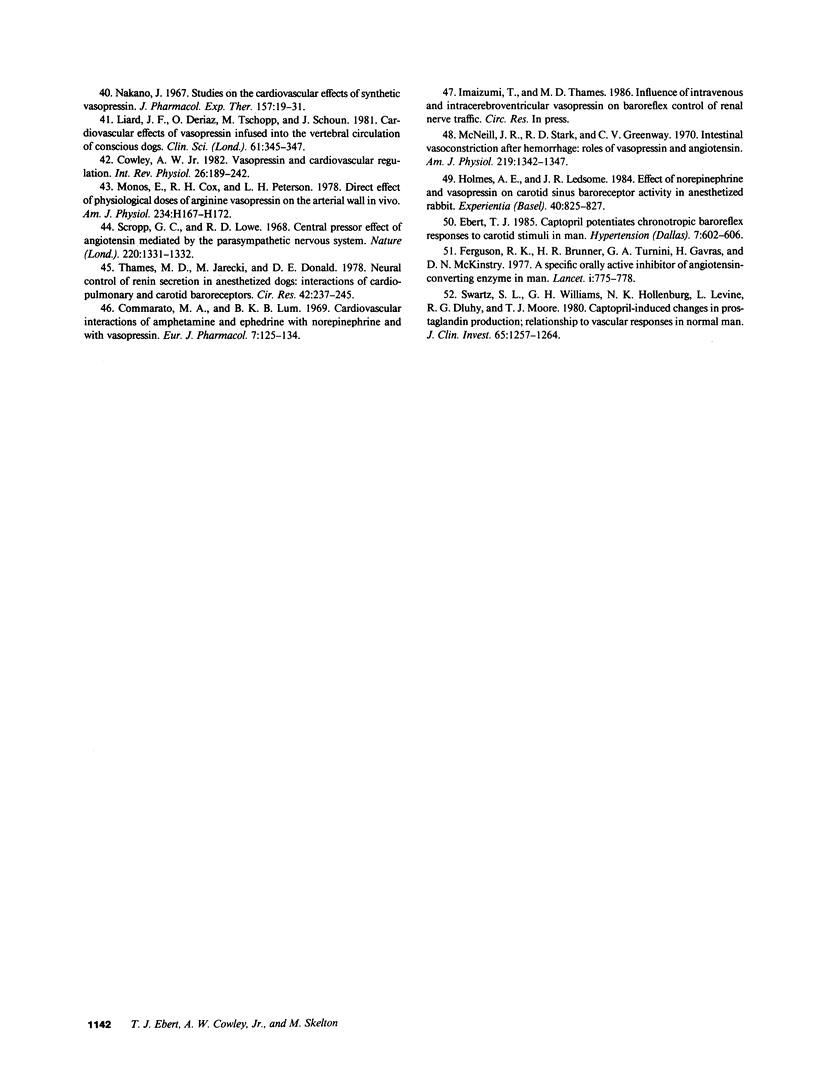
Selected References
These references are in PubMed. This may not be the complete list of references from this article.
- Altura B. M., Altura B. T. Vascular smooth muscle and neurohypophyseal hormones. Fed Proc. 1977 May;36(6):1853–1860. [PubMed] [Google Scholar]
- BARTELSTONE H. J., NASMYTH P. A. VASOPRESSIN POTENTIATION OF CATECHOLAMINE ACTIONS IN DOG, RAT, CAT, AND RAT AORTIC STRIP. Am J Physiol. 1965 Apr;208:754–762. doi: 10.1152/ajplegacy.1965.208.4.754. [DOI] [PubMed] [Google Scholar]
- BRAUNWALD E., WAGNER H. N., Jr The pressor effect of the antidiuretic principle of the posterior pituitary in orthostatic hypotension. J Clin Invest. 1956 Dec;35(12):1412–1418. doi: 10.1172/JCI103398. [DOI] [PMC free article] [PubMed] [Google Scholar]
- Boer P., Roos J. C., Geyskes G. G., Mees E. J. Measurement of cardiac output by impedance cardiography under various conditions. Am J Physiol. 1979 Oct;237(4):H491–H496. doi: 10.1152/ajpheart.1979.237.4.H491. [DOI] [PubMed] [Google Scholar]
- Commarato M. A., Lum B. K. Cardiovascular interactions of amphetamine and ephedrine with norepinephrine and with vasopressin. Eur J Pharmacol. 1969 Aug;7(2):125–134. doi: 10.1016/0014-2999(69)90001-6. [DOI] [PubMed] [Google Scholar]
- Cowley A. W., Jr, Cushman W. C., Quillen E. W., Jr, Skelton M. M., Langford H. G. Vasopressin elevation in essential hypertension and increased responsiveness to sodium intake. Hypertension. 1981 May-Jun;3(3 Pt 2):I93–100. doi: 10.1161/01.hyp.3.3_pt_2.i93. [DOI] [PubMed] [Google Scholar]
- Cowley A. W., Jr, Merrill D., Osborn J., Barber B. J. Influence of vasopressin and angiotensin on baroreflexes in the dog. Circ Res. 1984 Feb;54(2):163–172. doi: 10.1161/01.res.54.2.163. [DOI] [PubMed] [Google Scholar]
- Cowley A. W., Jr, Monos E., Guyton A. C. Interaction of vasopressin and the baroreceptor reflex system in the regulation of arterial blood pressure in the dog. Circ Res. 1974 Apr;34(4):505–514. doi: 10.1161/01.res.34.4.505. [DOI] [PubMed] [Google Scholar]
- Cowley A. W., Jr, Switzer S. J., Guinn M. M. Evidence and quantification of the vasopressin arterial pressure control system in the dog. Circ Res. 1980 Jan;46(1):58–67. doi: 10.1161/01.res.46.1.58. [DOI] [PubMed] [Google Scholar]
- Cowley A. W., Jr Vasopressin and cardiovascular regulation. Int Rev Physiol. 1982;26:189–242. [PubMed] [Google Scholar]
- Davies R., Forsling M. L. Proceedings: Vasopressin release after postural changes and syncope. J Endocrinol. 1975 Jun;65(3):59P–60P. [PubMed] [Google Scholar]
- Denniston J. C., Maher J. T., Reeves J. T., Cruz J. C., Cymerman A., Grover R. F. Measurement of cardiac output by electrical impedance at rest and during exercise. J Appl Physiol. 1976 Jan;40(1):91–95. doi: 10.1152/jappl.1976.40.1.91. [DOI] [PubMed] [Google Scholar]
- Ebert T. J. Captopril potentiates chronotropic baroreflex responses to carotid stimuli in humans. Hypertension. 1985 Jul-Aug;7(4):602–606. doi: 10.1161/01.hyp.7.4.602. [DOI] [PubMed] [Google Scholar]
- Ebert T. J. Carotid baroreceptor reflex regulation of forearm vascular resistance in man. J Physiol. 1983 Apr;337:655–664. doi: 10.1113/jphysiol.1983.sp014647. [DOI] [PMC free article] [PubMed] [Google Scholar]
- Ebert T. J., Eckberg D. L., Vetrovec G. M., Cowley M. J. Impedance cardiograms reliably estimate beat-by-beat changes of left ventricular stroke volume in humans. Cardiovasc Res. 1984 Jun;18(6):354–360. doi: 10.1093/cvr/18.6.354. [DOI] [PubMed] [Google Scholar]
- Ebert T. J., Smith J. J., Barney J. A., Merrill D. C., Smith G. K. The use of thoracic impedance for determining thoracic blood volume changes in man. Aviat Space Environ Med. 1986 Jan;57(1):49–53. [PubMed] [Google Scholar]
- Ferguson R. K., Turini G. A., Brunner H. R., Gavras H., McKinstry D. N. A specific orally active inhibitor of angiotensin-converting enzyme in man. Lancet. 1977 Apr 9;1(8015):775–778. doi: 10.1016/s0140-6736(77)92958-0. [DOI] [PubMed] [Google Scholar]
- Gabriel S., Atterhög J. H., Orö L., Ekelund L. G. Measurement of cardiac output by impedance cardiography in patients with myocardial infarction. Comparative evaluation of impedance and dye dilution methods. Scand J Clin Lab Invest. 1976 Jan;36(1):29–34. doi: 10.1080/00365517609068015. [DOI] [PubMed] [Google Scholar]
- Grossman S. H., Davis D., Gunnells J. C., Shand D. G. Plasma norepinephrine in the evaluation of baroreceptor function in humans. Hypertension. 1982 Jul-Aug;4(4):566–571. doi: 10.1161/01.hyp.4.4.566. [DOI] [PubMed] [Google Scholar]
- Heyndrickx G. R., Boettcher D. H., Vatner S. F. Effects of angiotensin, vasopressin, and methoxamine on cardiac function and blood flow distribution in conscious dogs. Am J Physiol. 1976 Nov;231(5 Pt 1):1579–1587. doi: 10.1152/ajplegacy.1976.231.5.1579. [DOI] [PubMed] [Google Scholar]
- Hill D. W., Mohapatra S. N., Welham K. C., Stevenson M. L. The effect of a progressive decrease in the circulating blood volume of the dog on the transthoracic impedance. Eur J Intensive Care Med. 1976 Nov;2(3):119–124. doi: 10.1007/BF00579692. [DOI] [PubMed] [Google Scholar]
- Holmes A. E., Ledsome J. R. Effect of norepinephrine and vasopressin on carotid sinus baroreceptor activity in the anesthetized rabbit. Experientia. 1984 Aug 15;40(8):825–827. doi: 10.1007/BF01951973. [DOI] [PubMed] [Google Scholar]
- Johnson J. M., Rowell L. B., Niederberger M., Eisman M. M. Human splanchnic and forearm vasoconstrictor responses to reductions of right atrial and aortic pressures. Circ Res. 1974 Apr;34(4):515–524. doi: 10.1161/01.res.34.4.515. [DOI] [PubMed] [Google Scholar]
- Khokhar A. M., Slater J. D., Ma J., Ramage C. M. The cardiovascular effect of vasopressin in relation to its plasma concentration in man and its relevance to high blood pressure. Clin Endocrinol (Oxf) 1980 Sep;13(3):259–266. doi: 10.1111/j.1365-2265.1980.tb01052.x. [DOI] [PubMed] [Google Scholar]
- Lababidi Z., Ehmke D. A., Durnin R. E., Leaverton P. E., Lauer R. M. Evaluation of impedance cardiac output in children. Pediatrics. 1971 May;47(5):870–879. [PubMed] [Google Scholar]
- Leon D. F., Shaver J. A., Leonard J. J. Reflex heart rate control in man. Am Heart J. 1970 Dec;80(6):729–739. doi: 10.1016/0002-8703(70)90133-x. [DOI] [PubMed] [Google Scholar]
- Liard J. F., Dériaz O., Tschopp M., Schoun J. Cardiovascular effects of vasopressin infused into the vertebral circulation of conscious dogs. Clin Sci (Lond) 1981 Sep;61(3):345–347. doi: 10.1042/cs0610345. [DOI] [PubMed] [Google Scholar]
- Luepker R. V., Michael J. R., Warbasse J. R. Transthoracic electrical impedance; quantitative evaluation of a non-invasive measure of thoracic fluid volume. Am Heart J. 1973 Jan;85(1):83–93. doi: 10.1016/0002-8703(73)90529-2. [DOI] [PubMed] [Google Scholar]
- McNeill J. R., Stark R. D., Greenway C. V. Intestinal vasoconstriction after hemorrhage: roles of vasopressin and angiotensin. Am J Physiol. 1970 Nov;219(5):1342–1347. doi: 10.1152/ajplegacy.1970.219.5.1342. [DOI] [PubMed] [Google Scholar]
- McNeill J. R., Wilcox W. C., Pang C. C. Vasopressin and angiotensin: reciprocal mechanisms controlling mesenteric conductance. Am J Physiol. 1977 Mar;232(3):H260–H266. doi: 10.1152/ajpheart.1977.232.3.H260. [DOI] [PubMed] [Google Scholar]
- Monos E., Cox R. H., Peterson L. H. Direct effect of physiological doses of arginine vasopressin on the arterial wall in vivo. Am J Physiol. 1978 Feb;234(2):H167–H172. doi: 10.1152/ajpheart.1978.234.2.H167. [DOI] [PubMed] [Google Scholar]
- Montani J. P., Liard J. F., Schoun J., Möhring J. Hemodynamic effects of exogenous and endogenous vasopressin at low plasma concentrations in conscious dogs. Circ Res. 1980 Sep;47(3):346–355. doi: 10.1161/01.res.47.3.346. [DOI] [PubMed] [Google Scholar]
- Myers H. A., Honig C. R. Influence of initial resistance on magnitude of response to vasomotor stimuli. Am J Physiol. 1969 Jun;216(6):1429–1436. doi: 10.1152/ajplegacy.1969.216.6.1429. [DOI] [PubMed] [Google Scholar]
- Möhring J., Glänzer K., Maciel J. A., Jr, Düsing R., Kramer H. J., Arbogast R., Koch-Weser J. Greatly enhanced pressor response to antidiuretic hormone in patients with impaired cardiovascular reflexes due to idiopathic orthostatic hypotension. J Cardiovasc Pharmacol. 1980 Jul-Aug;2(4):367–376. doi: 10.1097/00005344-198007000-00004. [DOI] [PubMed] [Google Scholar]
- Naggar C. Z., Dobnik D. B., Flessas A. P., Kripke B. J., Ryan T. J. Accuracy of the stroke index as determined by the transthoracic electrical impedance method. Anesthesiology. 1975 Feb;42(2):201–205. doi: 10.1097/00000542-197502000-00015. [DOI] [PubMed] [Google Scholar]
- Nakano J. Studies on the cardiovascular effects of synthetic vasopressin. J Pharmacol Exp Ther. 1967 Jul;157(1):19–31. [PubMed] [Google Scholar]
- Patterson R. P., Kubicek W. G., Witsoe D. A., From A. H. Studies on the effect of controlled volume change on the thoracic electrical impedance. Med Biol Eng Comput. 1978 Sep;16(5):531–536. doi: 10.1007/BF02457804. [DOI] [PubMed] [Google Scholar]
- Scher A. M., Ohm W. W., Bumgarner K., Boynton R., Young A. C. Sympathetic and parasympathetic control of heart rate in the dog, baboon and man. Fed Proc. 1972 Jul-Aug;31(4):1219–1225. [PubMed] [Google Scholar]
- Schmid P. G., Sharabi F. M., Guo G. B., Abboud F. M., Thames M. D. Vasopressin and oxytocin in the neural control of the circulation. Fed Proc. 1984 Jan;43(1):97–102. [PubMed] [Google Scholar]
- Scroop G. C., Lowe R. D. Central pressor effect of angiotensin mediated by the parasympathetic nervous system. Nature. 1968 Dec 28;220(5174):1331–1332. doi: 10.1038/2201331a0. [DOI] [PubMed] [Google Scholar]
- Sealey J. E., Gerten-Banes J., Laragh J. H. The renin system: Variations in man measured by radioimmunoassay or bioassay. Kidney Int. 1972 Apr;1(4):240–253. doi: 10.1038/ki.1972.34. [DOI] [PubMed] [Google Scholar]
- Secher N. J., Thomsen A., Arnsbo P. Measurement of rapid changes in cardiac stroke volume. An evaluation of the impedance cardiography method. Acta Anaesthesiol Scand. 1977;21(5):353–358. doi: 10.1111/j.1399-6576.1977.tb01231.x. [DOI] [PubMed] [Google Scholar]
- Segar W. E., Moore W. W. The regulation of antidiuretic hormone release in man: I. Effects of change in position and ambient temperature on blood ADH levels. J Clin Invest. 1968 Sep;47(9):2143–2151. doi: 10.1172/JCI105900. [DOI] [PMC free article] [PubMed] [Google Scholar]
- Smith J. J., Bush J. E., Wiedmeier V. T., Tristani F. E. Application of impedance cardiography to study of postural stress. J Appl Physiol. 1970 Jul;29(1):133–137. doi: 10.1152/jappl.1970.29.1.133. [DOI] [PubMed] [Google Scholar]
- Spertini F., Brunner H. R., Waeber B., Gavras H. The opposing effects of chronic angiotensin-converting enzyme blockade by captopril on the responses to exogenous angiotensin II and vasopressin vs. norepinephrine in rats. Circ Res. 1981 May;48(5):612–618. doi: 10.1161/01.res.48.5.612. [DOI] [PubMed] [Google Scholar]
- Swartz S. L., Williams G. H., Hollenberg N. K., Levine L., Dluhy R. G., Moore T. J. Captopril-induced changes in prostaglandin production: relationship to vascular responses in normal man. J Clin Invest. 1980 Jun;65(6):1257–1264. doi: 10.1172/JCI109788. [DOI] [PMC free article] [PubMed] [Google Scholar]
- Szczepańska-Sadowska E. Hemodynamic effects of a moderate increase of the plasma vasopressin level in conscious dogs. Pflugers Arch. 1973;338(4):313–322. doi: 10.1007/BF00586073. [DOI] [PubMed] [Google Scholar]
- Thames M. D., Jarecki M., Donald D. E. Neural control of renin secretion in anesthetized dogs. Interaction of cardiopulmonary and carotid baroreceptors. Circ Res. 1978 Feb;42(2):237–245. doi: 10.1161/01.res.42.2.237. [DOI] [PubMed] [Google Scholar]
- Varma S., Jaju B. P., Bhargava K. P. Mechanism of vasopressin-induced bradycardia in dogs. Circ Res. 1969 Jun;24(6):787–792. doi: 10.1161/01.res.24.6.787. [DOI] [PubMed] [Google Scholar]


